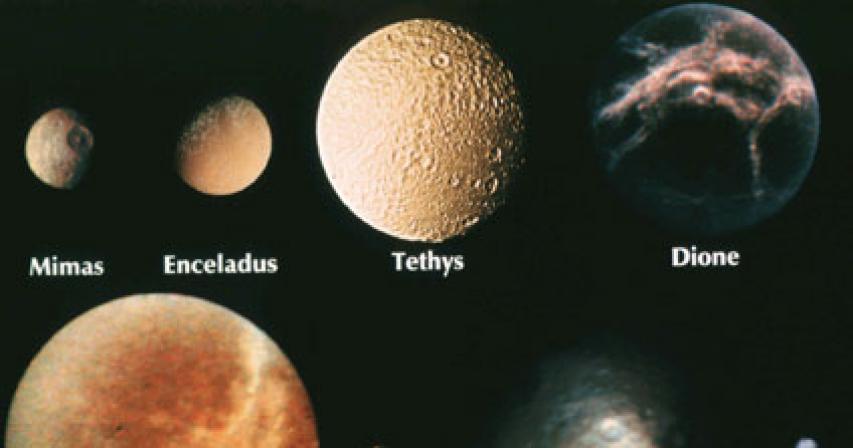In-Universe What are the Moons of Saturn?
- 4 years ago

Saturn has a large number of natural satellites. It's hard to say how many, since any piece of ice in the rings is technically a satellite, and it's not possible to distinguish between a large particle and a small moon.
Since July 19, 2007, 60 satellites have been identified, as well as 3 other bodies that could only cluster in the rings. 48 satellites have been confirmed and named.
Most of the known moons are small: 31 are less than 10 km in diameter, and 13 others less than 50 km. Only seven are massive enough to have taken on a spheroid shape under their gravity. Titan, the largest of them, larger than Mercury or Pluto, is the only satellite in the solar system to have a dense atmosphere.
All the satellites, for which the rotation period is known, except Phoebe and Hyperion, are synchronous. Traditionally, most of Saturn's moons have been named after Titans in Greek mythology.
Discovery of Saturn's moons
Most of Saturn's satellites have been discovered recently. However, the precise number of satellites will probably never be known. This is because the rings of the planet contain large chunks of ice which are technically moons and it is difficult to distinguish between large particles making up the ring and small moons.
Before the space age, only ten moons were known: Click here and have a look what are the moons of Saturn.
Titan (discovered in 1655)
Iapetus (1671)
Rhea (1672)
Tethys (1684)
Dioné (1684)
Mimas (1789)
Enceladus (1789)
Hyperion (1848)
Phoebe (1899)
Themis, a satellite that would have been discovered in 1905, does not exist.
Janus (1966, confirmed only in 1980, confused on certain observations with Epimetheus whose orbit he shares)
A team of astronomers from the University of Hawaii discovered, towards the end of 2004, twelve external satellites.
The discovery of nine new small outer satellites of Saturn was announced on June 26, 2006; they were discovered by DC Jewitt, SS Sheppard, and J. Kleyna using the 8.2 meter Subaru telescope: these are Hyrrokkin, S / 2006 S 1, Kari, S / 2006 S 3, Greip, Loge, Jarnsaxa, Surtur, and Skoll.
The discovery of a new external satellite, Tarqeq, was announced on April 13, 2007. That of S / 2007 S 2 and S / 2007 S 3, on May 1.
The discovery of Saturn's sixtieth moon, Antheus, was announced on July 19, 2007.
Groups of Saturn's satellites
Even if their limits are rather vague (or even subjective), it is possible to group Saturn's satellites into eight groups.
Shepherd satellites
Shepherd satellites are moons that orbit within or just at the edge of a system of planetary rings, sculpting the edges or creating gaps between them. The shepherd satellites of Saturn are Pan, Daphnis, Atlas, Prometheus, Pandora, as well as the unconfirmed satellites S / 2004 S 3, S / 2004 S 4 and S / 2004 S 6.
Janus and Epimetheus
Janus and Epimetheus are co-orbital moons. They are roughly the same size and their orbits are only a few km apart, closes enough that they will be condemned to collide if one tries to overtake the other. Instead, the different gravitational interactions cause their orbits to swap every four years.
Major internal satellites
The largest internal moons of Saturn orbit inside the E ring: Mimas, Enceladus, Tethys, and Dione.
Three other moons of much smaller size orbit in this group: Méthone, Anthée, and Pallène.
Trojan Satellites
The Trojan satellites are another kind of co-orbital: they orbit at the same distance as another moon, but at the Lagrange points L4 and L5; the stability of such a system means that these satellites never collide.
Tethys has two small Trojan satellites, Telesto and Calypso; Dioné also has two, Hélène and Pollux.
Major external satellites
The largest satellites of Saturn orbit beyond the E ring: Rhea, Hyperion (which is comparatively smaller and very irregular in shape), Titan and Iapetus.
Irregular satellites
Inuit group
The Inuit group is made up of five satellites, four of them named after Inuit deities) who share a similar distance to Saturn and orbital tilt: Kiviuq, Ijiraq, Paaliaq, Siarnaq, and Tarqeq.
Nordic group
The Nordic group is made up of 29 outer moons (most characteristically bearing the name of Nordic deities) which share a similar distance to Saturn and an orbital inclination: Phoebe, Skathi, Narvi, Mundilfari, Suttungr, Thrymr, Ymir, Ægir, Bergelmir, Bestla, Farbauti, Fenrir, Fornjot, Greip, Hati, Hyrrokkin, Jarnsaxa (moon), Kari, Loge, Skoll, Surtur, S / 2004 S 7, S / 2004 S 12, S / 2004 S 13, S / 2004 S 17, S / 2006 S 1, S / 2006 S 3, S / 2007 S 2 and S / 2007 S 3. All of these satellites orbit in a retrograde direction.
Celtic group
The Celtic group is made up of four outer moons (named after Celtic deities) that share a similar distance to Saturn and orbital tilt: Albiorix, Erriapo, Bebhionn, and Tarvos.
Comments